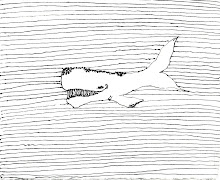I was recently at the Williams College Museum of Art for the Julie Mehretu exhibition "city sitings" I have drooled over a lot of Mehretu's drawings/paintings in books but have never seen any in person. They are large and beautiful. While I was there a woman approached me, she was probably in her 60's and she said "you look young, maybe you understand this stuff" (to be completely clear the "stuff" she was referring to was the art on the gallery walls). It was a brief conversation, mostly because I don't think this woman was really all that curious about this "stuff". She commented that she thought it was supposed to be a landscape in Africa, and that she didn't see any landscape. I suggested that it was not necessarily a concrete image that she was supposed to be viewing but a painting that draws from a number of sources, the urban environment, grids, maps, architectural plans. Then the lady said "okay" and proceeded to view the Europe and Midieval Collection.
I am really interested in the gap between generations of art viewing and art-making. I have felt this gap mostly in converstions I have with older artists. I was recently speaking with an artist in Boston, in the 1980's he was commissioned to make a number of bronze-cast public sculptures (i.e venus in a fountain or victorian lady with umbrella-that type of stuff) Listening to him talk about art, I realized that I really disagreed with his philosophy of art-making, so much so that I wondered if what I do as an artist is even close to what he does as an artist. The woman at Williams, she preferred to view European and Midieval art, (maybe she's looking at history). She assumed that because of my age, I could understand the "stuff" but that this "stuff" was beyond her, below her, whatever, just not for her. She lives in this world, so I think it is for her. It is a curious thing to consider how different generations of artists and art-viewers can engage in the same art.
Sunday, July 13, 2008
Monday, July 7, 2008
J. Kosuth Meets Worlds Largest Chair (all in my head)

Gardner, Massachusetts is known as "chair city" and claims they have the worlds largest chair. This chair sits on the front lawn of Gardner's public elementary school, as far as I can tell there is no other reason to go to Gardner, MA than to see this chair. Since seeing the chair I cannot stop thinking about Joseph Kosuth, "One and Three Chairs" in which Kosuth presents a chair, an image of a chair and a dictionary definition of a chair. In this piece things like an object and the physical representation of it, a concept and the means of presentation of the concept are explored. The connection between language (definition) picture and actual physical object is presented to the viewer and the viewer quesitons what is real, what holds and makes meaning? Which element cannot stand on its own? If the defintion of the chair did not exist would I still know what a chair was for?
back to Gardner, MA: the largest chair in the world. Does that object, that no one can sit in, that exists in the yard of an elementary school really function as a chair and if it doesn't function as a chair does/can it possibly hold meaning as a chair? There's really no end or resolution to these thoughts so this blog ends here.
Subscribe to:
Comments (Atom)
